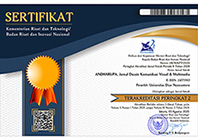Implementasi Nirmana pada Fotografi Portraiture 3D Anaglyph
DOI:
https://doi.org/10.33633/andharupa.v4i02.1790Abstract
AbstrakImplementasi teknologi 3D saat ini lebih banyak digunakan di dunia perfilman dan animasi, padahal teknologi tersebut memiliki potensi untuk dikembangkan dalam fotografi, khususnya fotografi 3D. Sampai saat ini masih sedikit fotografer yang mendalami dan tertarik untuk melakukan eksperimen. Fotografi 3D menyimpan potensi untuk dikembangkan karena implementasi 3D dapat membuat media foto tersebut menjadi sangat unik. Fotografi sendiri merupakan salah satu dari bidang ilmu pengetahuan, teknologi dan seni (IPTEKS), oleh karena itu ilmu fotografi seharusnya bergerak dinamis mengikuti perkembangan teknologi. Melalui penelitian yang mengarah pada eksperimental fotografi dan citra 3D diharapkan dapat memberikan kontribusi kebaharuan dalam fotografi. Karya fotografi juga memerlukan sentuhan dari nirmana karena nirmana merupakan ilmu yang mempelajari unsur-unsur tata rupa. Tujuan penelitian ini adalah menghasilkan karya-karya fotografi portraiture nirmana dengan teknologi 3D anaglyph. Dengan menggunakan metodologi eksperimental, penelitian ini mengeksplorasi teknik penciptaan fotografi 3D anaglyph. Luaran karya fotografi 3D tersebut menjadi bukti bahwa sisi estetis nirmana dan teknologi fotografi 3D anaglyph merupakan ilmu yang saling berhubungan dan implementatif satu sama lain secara khusus dengan ilmu fotografi. Kata kunci : 3D anaglyph, fotografi, nirmana, portraiture AbstractThe implementation of 3D technology recently is more applicated in film and animation, whereas that technology has big potential to develop in photography, especially the 3D photography genre. Until now, only a few photographers have focused on this genre and are interested in conducting further experiments. 3D photography still has the potential to be developed because 3D applications can produce unique photos. Photography is one of the science and technology fields, therefore photography should move dynamically in line with technological developments. Through research that leads to experimental photography and 3D imagery is expected to contribute novelty in photography. Photographic work also requires nirmana touch because nirmana learns the elements of fine arts. The purpose of this research is to produce portraiture photography works of nirmana with anaglyph 3D technology. By using the experimental methodology, this study explores 3D anaglyph photography creation techniques. The output of 3D photography is evidence that nirmana aesthetic and 3D photography technology are interrelated and implementative especially with the science of photography. Keywords : 3D anaglyph, photography, nirmana, portraitureReferences
Anggela, D. 2013. Perancangan Aplikasi Anaglyph Image dengan Menggunakan Metode Chromatic Anaglyphic pada Citra Berdasarkan Besarnya Jarak Pergeseran Warna. Jurnal Sistem dan Teknologi Informasi (JustIN), 1(3), 182-185.
Arofa, V. S. 2017. 1 Karakteristik Obyek 3 Dimensi. URL: www.scribd.com/document/336959987/1-Karakteristik-Obyek-3-Dimensi [Diakses pada 10 April 2018]
Cochran, W.G. 1977. Sampling Method. Jhon Welley & Son, INC
Nasir, Moh. 1988. Metode Penelitian. Jakarta: GI Press
Sanyoto, Sadjiman Ebdi. 2005. Dasar-Dasar Tata Rupa dan Desain (NIRMANA). Jogjakarta: Arti Bumi Intaran
Segara, T. M. 2012. Landasan Konseptual Perencanaan Dan Perancangan Akademi Dan Galeri Fotografi Di Yogyakarta Berdasarkan Pendekatan Arsitektur Metafora (Doctoral dissertation, UAJY).
Setyanto, Daniar Wikan. 2017. Perancangan Fotografi Esai “Semarang City By The Sea†Dengan Pendekatan EDFAT. Jurnal Andharupa, (03/02), 204-212.
Smith, Brian. 2007. Secrets of Great Portrait Photography. Elex Media Komputindo
Downloads
Published
Issue
Section
License
Copyright (c) 2018 ANDHARUPA: Jurnal Desain Komunikasi Visual & Multimedia

This work is licensed under a Creative Commons Attribution 4.0 International License.
Authors who publish with this journal agree to the following terms:
- Authors retain copyright and grant the journal right of first publication with the work simultaneously licensed under a Creative Commons Attribution License that allows others to share the work with an acknowledgment of the work's authorship and initial publication in this journal.
- Authors are able to enter into separate, additional contractual arrangements for the non-exclusive distribution of the journal's published version of the work (e.g., post it to an institutional repository or publish it in a book), with an acknowledgment of its initial publication in this journal.
- Authors are permitted and encouraged to post their work online (e.g., in institutional repositories or on their website) prior to and during the submission process, as it can lead to productive exchanges, as well as earlier and greater citation of published work (See The Effect of Open Access).















